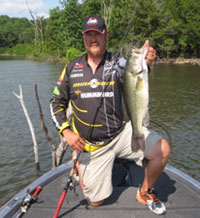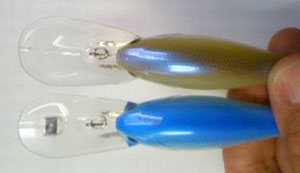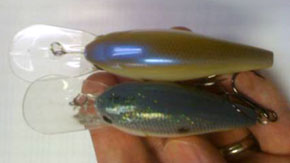A Whole Lotta Crankin’ Going On, Part 1 – Deep Diving Crankbaits
By Chip
Pillow, Lucky Craft Regional Pro Staff
Being from Memphis I have to give a little nod to Jerry
Lee Lewis with the title of this article. With that out of the
way, over the last couple of months I have been besieged by requests
for a review article like the previous one's I've written,
only this time focusing on clarifying the many different models of
Lucky Craft crankbaits. There was this part of me that was excited
that I get to talk about crankbaits. I mean for me they ought
to be called "crack-baits" because I am addicted to fishing
(and buying) them. On the other hand there was this part of me
that was a little dumbfounded as well. Because Lucky Craft has
a large selection of crankbaits, I was being asked questions about
baits I was not incredibly familiar with. Ok, so what does one
do when confronted with an issue in which there is little clarity? You
guessed it! Go buy more tackle and go fishing. Parenthetically,
my wife has a hard time conceptualizing how these trips were "research". However,
I must press on in the interest of "science" (told you
they should be called crack-baits).
So
after several trips to my local tackle shop, multiple trips to the
lake, and talking with other Lucky Craft pro's I have decided
to break the articles into multiple parts. In this article I
am going to focus on Lucky Craft deep diving crankbaits. By deep
I am going to include baits that dive deeper than 10 feet. These
will include Lucky Craft as well as the Rick Clunn Lucky Craft cranks
sold exclusively at Bass Pro Shop. Part II will focus
on the "Signature Series" of Lucky Craft baits. By their
very nature, the signature series dives relatively shallow (e.g. less than
10 feet). This article will cover the poplar SKT line of baits. In
Part III of this series I plan on discussing the Lucky Craft "fat" line
of crankbaits.
Flat CB - In all of these review
articles I have tried to stress how Lucky Craft baits are specific
tools for a specific purpose. Lucky
Craft crankbait lines are no different. The Flat CB series of
crankbaits are designed for open water applications, such as ledge
fishing or long tapering points. As the name implies, the body
of the bait is narrow which allows its action to take advantage of
Lucky Craft's realistic finishes by giving
off an iridescent reflection as it oscillates in the water. The
narrow body also displaces a lot of water as the bait is moving through
the water.
Another aspect of the Flat CB's that make is shine
in open water is Lucky Craft's weight transfer system. All
of us have been there. We are out on our favorite ledge and there's
a good wind providing that perfect chop on the water. With visions
of 4 pounders dancing in our head, we rare back and fire our favorite
crankbait, only to have it "helicopter" in the wind and
land about 40 feet from the boat. No good! The weight
transfer system in the Flat CB crankbaits addresses this issue. As
the angler draws and fires the Flat CB, the internal tungsten weight
is positioned into a cavity in the tail of the bait. With the
tungsten weight in the tail, the CB is far less likely to spiral or
helicopter, thus allowing for far greater casting distance and far
fewer backlashes. Once the bait hits the water, reel in the slack
and give the CB a good pull to start its decent. This pull repositions
the internal weight into the nose of the bait. With the weight
repositioned, the CB dives at a very sharp angle allowing for maximum
time the bait is in the strike zone. Once bottom contact, or
maximum depth, is achieved, the tungsten ball moves toward the center
of the front cavity providing the bait with a natural swimming position
while also giving the bait great deflective action off of stumps and
rocks.
A final
advantage of the Flat CB internal weight transfer system is the unique
sound the bait possesses. The positioning of the primary tungsten
ball provides the Flat CB with a deep, throaty "thud" sound. This
sound is similar to the old style "one-knocker" baits. A
second tungsten ball, which is stationary and much smaller, adds a
little more volume and a slightly higher pitch. Thus making the
Flat CB a loud and flashy bait that is an excellent bait to excite
a school and trigger aggressive strikes from active as well as inactive
fish.
The Flat CB comes in 4 different sizes: the MR (2.5",
3/8 oz. and dives to 4-5 ft.) the DR (2.5", 1/2 oz. and dives
9-10 ft.), the D 12 (3", 3/4 oz.
dives to 12 ft.), and the D 20 (3", 3/4 oz. dives down to
20 ft.). The
DR and MR come equipped with #4 hooks, while the D12 and D20 come with
#2's. The
variance of models allows the angler to target the specific depth range
at which the fish are positioned.
A great,
but often overlooked, deep cranking pattern is to swim the Flat CB
through deep trees to catch suspended summertime bass. While
this is not your "typical" deep
cranking pattern, this approach can be highly productive during the
dog days of summer. BASS and FLW Stren pro Doug Vahrenberg (www.dougvahrenberg.com)
told me he uses the Flat CB to target bass in trees. He likes
the Flat CB's because the bill design minimizes hang ups while
banging the bait through deep trees. Doug will use his Humminbird
Side Imaging to detect the specific depth at which the fish are holding
in the trees and then use different models and line sizes to achieve
the desired depth. Notice
the picture below. You can see the tree, which is well off the
bank, where Doug caught the fish using this technique. That's
the kind of fish that will make your morning fun!
 One
of my favorite deep cranking patterns is when inactive fish are positioned "semi-suspended" just
off the side of the ledge. I can see with my Humminbird that
they are not actively feeding on top or right at the break, but are
located several feet off the ledge just sitting there "floating". Depending
on the depth of the fish, I will use the appropriate CB to plow off
the ledge and when I feel the crankbait lose bottom contact I will
stop the retrieve and allow the bait to hover right in front of the
fish. After bouncing around on the bottom, the CB will slowly
begin to wiggle as it rises in the water column. I will give
the bait very slight pops on a slack line. Don't pull the
bait with your rod and don't over pop it. Just a slight
snap that will move the bait several inches forward. I want
the crankbait to just sit right in front of these suspended fish. As
is slowly rises, they can't help but want an easy meal. This
technique will often ignite the most sluggish school of bass.
One
of my favorite deep cranking patterns is when inactive fish are positioned "semi-suspended" just
off the side of the ledge. I can see with my Humminbird that
they are not actively feeding on top or right at the break, but are
located several feet off the ledge just sitting there "floating". Depending
on the depth of the fish, I will use the appropriate CB to plow off
the ledge and when I feel the crankbait lose bottom contact I will
stop the retrieve and allow the bait to hover right in front of the
fish. After bouncing around on the bottom, the CB will slowly
begin to wiggle as it rises in the water column. I will give
the bait very slight pops on a slack line. Don't pull the
bait with your rod and don't over pop it. Just a slight
snap that will move the bait several inches forward. I want
the crankbait to just sit right in front of these suspended fish. As
is slowly rises, they can't help but want an easy meal. This
technique will often ignite the most sluggish school of bass.
Rick Clunn - RC DD - Many times after
a seminar I am approached by anglers with questions regarding Lucky
Craft crankbaits. The one I hear most often involves something
along the lines of "Why do that have so many different crankbaits?" As
I noted in a previous article on Lucky Craft jerkbaits, the sheer volume
of lures hanging on the shelf is enough to intimidate even the strong
of heart. When you add the RC crankbaits from Bass Pro Shop,
the volume, and confusion, seems to grow exponentially. In this
section I'm going discuss and clarify the RC DD crankbaits. These
baits are markedly different from the Flat CB and serve a very different
purpose.
The RC DD comes in several sizes. For the purposes of this
article I am going to limit the discussion to the following: 2.5 DD (2-3/4",
5/8th oz. dives to 10 ft), 3.5 DD (3" 3/4 oz. dives to 14 ft) and
the new 3.5 XD (3-1/4 in. 1 oz. and dives 18-20 ft).
The new
3.5 XD has a tungsten weighted bill and does not have rattles.
 Notice
the picture. The RC XD (on the bottom) has a slightly narrower
bill compared to the CB 20. This design allows for a tighter
wobble while achieving the same depth. Noted deep cranking expert,
and Lake Fork guide, Tom Redington (http://www.lakeforkguidetrips.com/)
loves the addition of the new bait for highly pressured fish. The
FLW tour pro told me, "Combining the Flat CB D20 with the RC
3.5 XD makes a great 1-2 combo. First, use the louder and flashier
D20 to excite the school and trigger the most active fish. Once
the bite slows, switch to the more finesse 3.5 XD and you'll
often be able to pick up additional fish after they have stopped chasing
conventional offerings."
Notice
the picture. The RC XD (on the bottom) has a slightly narrower
bill compared to the CB 20. This design allows for a tighter
wobble while achieving the same depth. Noted deep cranking expert,
and Lake Fork guide, Tom Redington (http://www.lakeforkguidetrips.com/)
loves the addition of the new bait for highly pressured fish. The
FLW tour pro told me, "Combining the Flat CB D20 with the RC
3.5 XD makes a great 1-2 combo. First, use the louder and flashier
D20 to excite the school and trigger the most active fish. Once
the bite slows, switch to the more finesse 3.5 XD and you'll
often be able to pick up additional fish after they have stopped chasing
conventional offerings."
I
have found Tom's advice to prove true time and time again. How
many times have all of us picked up some good crankbait fish only to
have the school shut down after several bites. We just assume
the school has moved or is no longer interested. Here is where
the XD can add some extra fish to the live well. There are even
times when the bigger fish, especially later in the summer when they've
seen every crankbait in three counties, only want the subtle action
of the new XD. Then again Tom ought to know. He's
caught more 10 lb crankbait fish than any one I know.
The other
place I have found the 3.5 XD to be invaluable is when fish are extremely
lethargic. For
example, when the water temp is dipping bass don't want a loud,
wide wobbling crankbait. With its tight wiggle and subtle approach,
the XD is able to move into the strike zone without spooking fish. Slowly
grinding this crankbait over ledges in the late winter, or early spring
is a dynamite tactic; or using a stop and go retrieve after cold fronts
can save your day. You
won't catch many fish, but the ones you do catch often make the
trip worthwhile.
 Moving
on to the RC 2.5 DD (2-3/4". 5/8th oz. dives around
10 feet) and 3.5 DD (3", 3/4 oz. and dives around 14 ft). These
baits come in two different models: rattling and silent. The
rattles in the RC series have an entirely different sound than the
Flat CB. Instead of the deep
thud of the Flat CB, the RC's have a smaller diameter ball, given
the bait a higher pitched, busier, sound. In
the picture of the RC 2.5 DD (bottom) and the CB 12, you can see how
the RC has a wider, "stubbier" bill and has a smaller body
size. This
design gives the RC 2.5 DD and 3.5 DD a wider wobble. The characteristics
make the RC baits an excellent choice in early post spawn to early
summer, and then again in early fall.
Moving
on to the RC 2.5 DD (2-3/4". 5/8th oz. dives around
10 feet) and 3.5 DD (3", 3/4 oz. and dives around 14 ft). These
baits come in two different models: rattling and silent. The
rattles in the RC series have an entirely different sound than the
Flat CB. Instead of the deep
thud of the Flat CB, the RC's have a smaller diameter ball, given
the bait a higher pitched, busier, sound. In
the picture of the RC 2.5 DD (bottom) and the CB 12, you can see how
the RC has a wider, "stubbier" bill and has a smaller body
size. This
design gives the RC 2.5 DD and 3.5 DD a wider wobble. The characteristics
make the RC baits an excellent choice in early post spawn to early
summer, and then again in early fall.
If you own an RC I have two words for you: muscle bed. If you have
muscle beds on your body of water, I have two letters for you: R. C. I
am not sure what it is about this bait smacking across the top of a
shell bed. I could
probably fake my way through a very eloquent sounding answer involving
wiggle, oscillation, lateral line and pork chops. But it would
be nothing but blown smoke in a posterior direction. Seriously,
I don't have an
answer. What I do know is that if I happen to find a muscle bed,
you can bet your hat I'm going to drag a RC across it. On
the Tennessee River System of lakes, you can pull an RC across a shell
bed in the post spawn and get your arm broken. Proof's
in the Pudding. Remember
the 2009 BassMaster Elite Series tournament on Guntersville? It
seemed like half of the top 10 were throwing some form of RC crankbait
on shell beds. When there was grass and shells mixed, it was lights out.
In conclusion, I want to say again that Lucky Craft crankbaits are
specific tools for specific conditions. Hopefully this article
has added some clarity to your deep cranking questions. If not,
you can always do what I do: grab some Lucky Craft crankbaits and go
spend some quality time on the water. Experience and time are
the best teachers.

